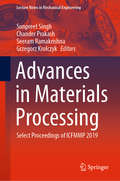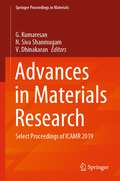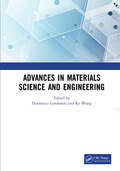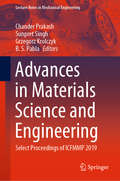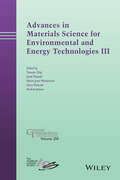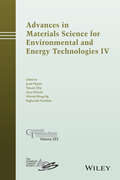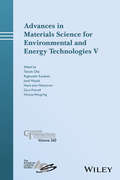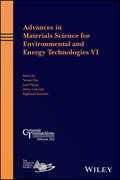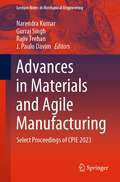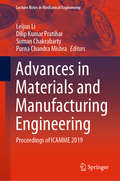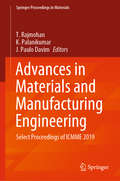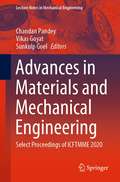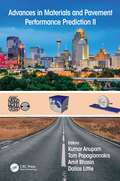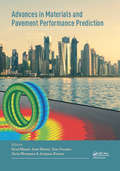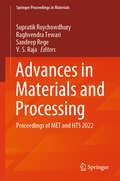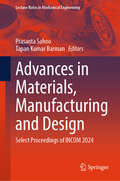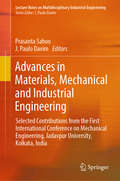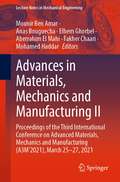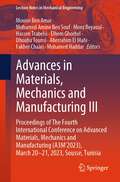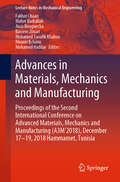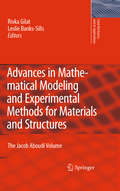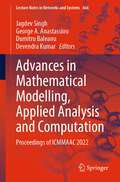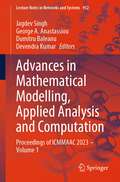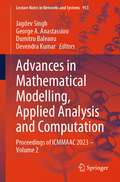- Table View
- List View
Advances in Materials Processing: Select Proceedings of ICFMMP 2019 (Lecture Notes in Mechanical Engineering)
by Seeram Ramakrishna Chander Prakash Sunpreet Singh Grzegorz KrolczykThis book presents the select proceedings of the International Conference on Functional Material, Manufacturing and Performances (ICFMMP) 2019. The book primarily covers recent research, theories, and practices relevant to surface engineering and processing of materials. It focuses on the lesser-known technologies and advanced manufacturing methods which may not be standardized yet but are highly beneficial to material and manufacturing industrial engineers. The book includes current advances in the field of coating, deposition, cladding, nanotechnology, surface finishing, precision machining, processing, and emerging advanced manufacturing technologies which enhance the performance of materials in terms of corrosion, wear and fatigue. The book can be a valuable reference for beginners, researchers, and professionals interested in materials processing and allied fields.
Advances in Materials Research: Select Proceedings of ICAMR 2019 (Springer Proceedings in Materials #5)
by N. Siva Shanmugam G. Kumaresan V. DhinakaranThis book comprises select peer-reviewed proceedings of the International Conference on Advances in Materials Research (ICAMR 2019). The contents cover latest research in materials and their applications relevant to composites, metals, alloys, polymers, energy and phase change. The indigenous properties of materials including mechanical, electrical, thermal, optical, chemical and biological functions are discussed. The book also elaborates the properties and performance enhancement and/or deterioration in order of the modifications in atomic particles and structure. This book will be useful for both students and professionals interested in the development and applications of advanced materials.
Advances in Materials Science and Engineering: Proceedings of the 7th Annual International Workshop on Materials Science and Engineering, (IWMSE 2021), Changsha, Hunan, China, 21-23 May 2021
by Domenico LombardoThis volume contains the selected papers resulting from the 7th Annual International Workshop on Materials Science and Engineering, and is focusing on the following six aspects: 1. Various Materials Properties, Processing, and Manufactures; 2. Multifunctional Materials Properties, Processing, and Manufactures; 3. Nanomaterials and Biomaterials; 4. Civil Materials and Sustainable Environment; 5. Electrochemical Valuation, Fracture Resistance, and Assessment; 6. Designs Related to Materials Science and Engineering. This proceeding presents and discusses key concepts and analyzes the state-of-the-art of the field. IWMSE 2021 is an academic conference in a series held once per year. The conference not only provides insights on materials science and engineering, but also affords conduit for future research in these fields. It provides opportunities for the delegates to exchange new ideas and application experiences, to establish business or research relations and to find global partners for future collaboration.
Advances in Materials Science and Engineering: Select Proceedings of ICFMMP 2019 (Lecture Notes in Mechanical Engineering)
by Chander Prakash B. S. Pabla Sunpret Singh Grzegorz KrolczykThis book presents the select proceedings of the International Conference on Functional Material, Manufacturing and Performances (ICFMMP) 2019. The book provides the state-of-the-art research, development, and commercial prospective of recent advances in materials science and engineering. The contents cover various synthesis and fabrication routes of functional and smart materials for applications in mechanical engineering, manufacturing, metrology, nanotechnology, physics, chemical and biological sciences, civil engineering, food science among others. It also provides the evolutionary behavior of materials science for industrial applications. This book will be a useful resource for researchers as well as professionals interested in the highly interdisciplinary field of materials science.
Advances in Materials Science for Environmental and Energy Technologies III
by Andrei Jitianu Tatsuki Ohji Navin Jose Manjooran Gary Pickrell Josef MatyasWith contributed papers from the 2011 Materials Science and Technology symposia, this is a useful one-stop resource for understanding the most important issues in advances in materials science for environmental and energy technologies. Logically organized and carefully selected, the articles cover the themes of the symposia: Green Technologies for Materials Manufacturing and Processing; Materials Science Challenges for Nuclear Applications; Materials for Nuclear Waste Disposal and Environmental Cleanup; Energy Conversion/Fuel Cells; and Energy Storage: Materials, Systems and Applications.
Advances in Materials Science for Environmental and Energy Technologies IV
by Tatsuki Ohji Gary Pickrell Josef Matyas Winnie K. Wong-Ng Raghunath KanakalaThis proceedings contains a collection of 20 papers from the following five 2014 Materials Science and Technology (MS&T'14) symposia: Materials Issues in Nuclear Waste Management in the 21st Century Green Technologies for Materials Manufacturing and Processing V Nanotechnology for Energy, Healthcare and Industry Materials for Processes for CO2 Capture, Conversion, and Sequestration Materials Development for Nuclear Applications and Extreme Environments
Advances in Materials Science for Environmental and Energy Technologies V
by Tatsuki Ohji Navin Jose Manjooran Gary Pickrell Raghunath Kanakala Winnie Wong-Ng Josef MatyášThis proceedings volume contains a collection of 20 papers from the following symposia held during the 2015 Materials Science and Technology (MS&T '15) meeting: 7th International Symposium on Green and Sustainable Technologies for Materials Manufacturing Processing Materials for Nuclear Applications and Extreme Environments Materials Issues in Nuclear Waste Management in the 21st Century Nanotechnology for Energy, Healthcare and Industry Materials for Processes for CO2 Capture, Conversion and Sequestration Hybrid Organic - Inorganic Materials for Alternative Energy
Advances in Materials Science for Environmental and Energy Technologies VI: Ceramic Transactions (Ceramic Transactions #Vol. 262)
by Tatsuki Ohji Raghunath Kanakala Josef Matyáš Henry ColoradoThis proceedings volume contains a collection of 20 papers from the 2016 Materials Science and Technology (MS&T'16) meeting held in Salt Lake City, UT, from October 24-27 of that year. These conference symposia provided a forum for scientists, engineers, and technologists to discuss and exchange state-of-the-art ideas, information, and technology on advanced methods and approaches for processing, synthesis, characterization, and applications of ceramics, glasses, and composites. <p><p> Topics covered include: the 8th International Symposium on Green and Sustainable Technologies for Materials Manufacturing Processing; Materials Issues in Nuclear Waste Management in the 21st Century; Construction and Building Materials for a Better Environment; Materials for Nuclear Applications and Extreme Environments; Nanotechnology for Energy, Healthcare, and Industry; and Materials for Processes for CO2 Capture, Conversion and Sequestration.
Advances in Materials and Agile Manufacturing: Select Proceedings of CPIE 2023 (Lecture Notes in Mechanical Engineering)
by J. Paulo Davim Narendra Kumar Gurraj Singh Rajiv TrehanThis book presents the select proceedings of International Conference on Production and Industrial Engineering (CPIE) 2023. It covers the current and latest developments in material and agile manufacturing. Various topics covered in this book include material characterization, agile manufacturing, materials and processing, joining processes (welding), surface engineering and coatings, sustainability in manufacturing, and many more. The book is useful for researchers and professionals working in manufacturing and materials engineering and other allied fields.
Advances in Materials and Manufacturing Engineering: Proceedings of ICAMME 2019 (Lecture Notes in Mechanical Engineering)
by Leijun Li Dilip Kumar Pratihar Suman Chakrabarty Purna Chandra MishraThis book gathers outstanding papers presented at the International Conference on Advances in Materials and Manufacturing Engineering (ICAMME 2019), held at KIIT Deemed to be University, Bhubaneswar, India, from 15 to 17 March 2019. It covers theoretical and empirical developments in various areas of mechanical engineering, including manufacturing, production, machine design, fluid/thermal engineering, and materials.
Advances in Materials and Manufacturing Engineering: Select Proceedings of ICMME 2019 (Springer Proceedings in Materials #7)
by J. Paulo Davim T. Rajmohan K. PalanikumarThis book comprises selected papers from the Fourth International Conference on Materials and Manufacturing Engineering (ICMME 2019). The contents focus on the latest developments in the synthesis and characterization of new materials, and highlights the challenges involved in the manufacturing and machinability of different materials. Advanced and cost-effective manufacturing processes and their applications are also discussed in the book. In addition, it covers topics like robotics, fluid dynamics, design and development, and different optimization techniques. The contents of this book will be beneficial to students, researchers, and industry professionals.
Advances in Materials and Mechanical Engineering: Select Proceedings of ICFTMME 2020 (Lecture Notes in Mechanical Engineering)
by Chandan Pandey Sunkulp Goel Vikas GoyatThis book presents the select proceedings of 1st International Conference on Future Trends in Materials and Mechanical Engineering (ICFTMME-2020), organised by Mechanical Engineering Department, SRM Institute of Science and Technology (Formerly known as SRM University), Delhi-NCR Campus, Ghaziabad, Uttar Pradesh, India. The book provides a deep insight of future trends in the advancement of materials and mechanical engineering. A broad range of topics and issues in material development and modern mechanical engineering are covered including polymers, nanomaterials, magnetic materials, fiber composites, stress analysis, design of mechanical components, theoretical and applied mechanics, tribology, solar, additive manufacturing and many more. This book will prove its worth to a broad readership of engineering students, researchers, and professionals.
Advances in Materials and Metallurgy: Select Proceedings Of Icemmm 2018 (Lecture Notes In Mechanical Engineering)
by A. K. Lakshminarayanan Sridhar Idapalapati M. VasudevanThis book presents select proceedings of the International Conference on Engineering Materials, Metallurgy and Manufacturing (ICEMMM 2018), and covers topics regarding both the characterization of materials and their applications across engineering domains. It addresses standard materials such as metals, polymers and composites, as well as nano-, bio- and smart materials. In closing, the book explores energy, the environment and green processes as related to materials engineering. Given its content, it will prove valuable to a broad readership of students, researchers, and professionals alike.
Advances in Materials and Pavement Performance Prediction II: Contributions to the 2nd International Conference on Advances in Materials and Pavement Performance Prediction (AM3P 2020), 27-29 May, 2020, San Antonio, TX, USA
by D. Little A. Kumar A. T. Papagiannakis A. BhasinInspired from the legacy of the previous four 3DFEM conferences held in Delft and Athens as well as the successful 2018 AM3P conference held in Doha, the 2020 AM3P conference continues the pavement mechanics theme including pavement models, experimental methods to estimate model parameters, and their implementation in predicting pavement performance. The AM3P conference is organized by the Standing International Advisory Committee (SIAC), at the time of this publication chaired by Professors Tom Scarpas, Eyad Masad, and Amit Bhasin. Advances in Materials and Pavement Performance Prediction II includes over 111 papers presented at the 2020 AM3P Conference. The technical topics covered include:- rigid pavements- pavement geotechnics- statistical and data tools in pavement engineering- pavement structures- asphalt mixtures - asphalt binders The book will be invaluable to academics and engineers involved or interested in pavement engineering, pavement models, experimental methods to estimate model parameters, and their implementation in predicting pavement performance.
Advances in Materials and Pavement Prediction: Papers from the International Conference on Advances in Materials and Pavement Performance Prediction (AM3P 2018), April 16-18, 2018, Doha, Qatar
by Eyad Masad; Amit Bhasin; Tom Scarpas; Ilaria Menapace; Anupam KumarAdvances in Materials and Pavement Performance Prediction contains the papers presented at the International Conference on Advances in Materials and Pavement Performance Prediction (AM3P, Doha, Qatar, 16- 18 April 2018). There has been an increasing emphasis internationally in the design and construction of sustainable pavement systems. Advances in Materials and Pavement Prediction reflects this development highlighting various approaches to predict pavement performance. The contributions discuss links and interactions between material characterization methods, empirical predictions, mechanistic modeling, and statistically-sound calibration and validation methods. There is also emphasis on comparisons between modeling results and observed performance. The topics of the book include (but are not limited to): • Experimental laboratory material characterization• Field measurements and in situ material characterization• Constitutive modeling and simulation• Innovative pavement materials and interface systems• Non-destructive measurement techniques• Surface characterization, tire-surface interaction, pavement noise• Pavement rehabilitation• Case studies Advances in Materials and Pavement Performance Prediction will be of interest to academics and engineers involved in pavement engineering.
Advances in Materials and Processing: Proceedings of MET and HTS 2022 (Springer Proceedings in Materials #63)
by V. S. Raja Supratik Roychowdhury Raghvendra Tewari Sandeep RegeThis book contains papers by experts from academia, R&D and industry on the state-of-the-art information on materials and processing, materials characterisation and testing, failure analysis, and advances in heat treatment. This book includes papers on advanced manufacturing processes in addition to advances in conventional processes, such as casting and welding. The book includes papers on state-of-the-art characterization techniques and mechanical testing, etc., for advanced materials, such as high entropy alloys and Al and Zr alloys to name a few. Papers on failure analysis case studies from nuclear, automobile, aviation, and oil and gas industry and on ageing management, residual life assessment, and failure mechanisms have relevance to industry. It also includes details on the current challenges, industry standards, and safety aspects for the heat treatment industry. The information provided is a valuable addition to the existing literature and will serve as a reference for R&D, academia, and industry.
Advances in Materials, Manufacturing and Design: Select Proceedings of INCOM 2024 (Lecture Notes in Mechanical Engineering)
by Prasanta Sahoo Tapan Kumar BarmanThis book presents select papers from the International Conference on Mechanical Engineering (INCOM 2024), describing recent advances in materials, manufacturing, and design of mechanical components. Various topics covered in this book are additive manufacturing, automation in manufacturing system, CAM, CAD-CAM, CIM, composite materials, computational solid and structural mechanics, engineering system design, functionally graded composites and smart materials, laser material processing, mechanics of composite materials, mechatronics, control and robotics. The book is a valuable reference for researchers and professionals working in the field of materials, mechanical and design engineering.
Advances in Materials, Mechanical and Industrial Engineering: Selected Contributions from the First International Conference on Mechanical Engineering, Jadavpur University, Kolkata, India (Lecture Notes on Multidisciplinary Industrial Engineering)
by J. Paulo Davim Prasanta SahooThis book presents selected extended papers from The First International Conference on Mechanical Engineering (INCOM2018), realized at the Jadavpur University, Kolkata, India. The papers focus on diverse areas of mechanical engineering and some innovative trends in mechanical engineering design, industrial practices and mechanical engineering education. Original, significant and visionary papers were selected for this edition, specially on interdisciplinary and emerging areas. All papers were peer-reviewed.
Advances in Materials, Mechanics and Manufacturing II: Proceedings of the Third International Conference on Advanced Materials, Mechanics and Manufacturing (A3M’2021), March 25-27, 2021 (Lecture Notes in Mechanical Engineering)
by Fakher Chaari Mohamed Haddar Mounir Ben Amar Anas Bouguecha Elhem Ghorbel Aberrahim El MahiThis book reports on innovative materials research with a special emphasis on methods, modeling, and simulation tools for analyzing material behavior, emerging materials, and composites, and their applications in the field of manufacturing. Chapters are based on contributions to the third International Conference on Advanced Materials Mechanics and Manufacturing, A3M2021, organized by the Laboratory of Mechanics, Modeling, and Manufacturing (LA2MP) of the National School of Engineers of Sfax, Tunisia and held online on March 25-27, 2021. They cover a variety of topics, spanning from experimental analysis of material plasticity and fatigue, numerical simulation of material behavior, and optimization of manufacturing processes, such as cutting and injection, among others. Offering a good balance of fundamental research and industrially relevant findings, they provide researchers and professionals with a timely snapshot of and extensive information on current developments in the field and a source of inspiration for future research and collaboration.
Advances in Materials, Mechanics and Manufacturing III: Proceedings of The Fourth International Conference on Advanced Materials, Mechanics and Manufacturing (A3M’2023), March 20-21, 2023, Sousse, Tunisia (Lecture Notes in Mechanical Engineering)
by Fakher Chaari Mohamed Haddar Mounir Ben Amar Mohamed Amine Ben Souf Elhem Ghorbel Aberrahim El Mahi Moez Beyaoui Hassen Trabelsi Dhouha TounsiThis book reports on innovative materials research with a special emphasis on methods, modeling, and simulation tools for analyzing material behavior, emerging materials, and composites, and their applications in manufacturing and automotive, among others. It gathers the proceedings of the fourth International Conference on Advanced Materials Mechanics and Manufacturing, A3M2023, held on March 20-21, 2023, in Sousse, Tunisia, and organized by the Laboratory of Mechanics, Modeling, and Manufacturing (LA2MP) of the National School of Engineers of Sfax. The book covers findings from experimental analyses and numerical simulations of material behavior, characterization of new materials, structures and composites, optimization methods and Artifical Intelligence applications. Offering a good balance of fundamental research and practice-oriented findings, it provides researchers and professionals with a timely snapshot of engineering methods in mechanics, materials and manufacturing.
Advances in Materials, Mechanics and Manufacturing: Proceedings of the Second International Conference on Advanced Materials, Mechanics and Manufacturing (A3M’2018), December 17–19, 2018 Hammamet, Tunisia (Lecture Notes in Mechanical Engineering)
by Fakher Chaari Mohamed Haddar Maher Barkallah Anas Bouguecha Bassem Zouari Mohamed Taoufik Khabou Mounir KchaouThis book reports on cutting-edge findings concerning characterization of material behavior, material modeling and simulation, and applications in the field of manufacturing. Based on the second International Conference on Advanced Materials Mechanics & Manufacturing, A3M2018, organized by the Laboratory of Mechanics, Modeling and Manufacturing (LA2MP) of the National School of Engineers of Sfax, Tunisia, the book covers a variety of topics, such as experimental analysis of material plasticity and fatigue, numerical simulation of material behavior, and optimization of manufacturing processes, such as cutting and injection, among others. It offers a timely snapshot on current research and applications, offering a bridge to facilitate communication and collaboration between academic and industrial researchers.
Advances in Mathematical Modeling and Experimental Methods for Materials and Structures: The Jacob Aboudi Volume (Solid Mechanics and Its Applications #168)
by Leslie Banks-Sills Rivka GilatThis work presents a collection of papers, written by leading authors in honor of Professor Jacob Aboudi. Jacob Aboudi served as Head of the Department of Solid Mechanics, Materials and Structures, as Dean of the Faculty of Engineering and as Incumbent of the Diane and Arthur Belfer Chair of Mechanics and Biomechanics. Aboudi has published more than 200 papers, 2 books and is a leading authority in the field of composite materials. The papers in this volume cover a wide spectrum of topics in the forefront of research in experimental methods and mathematical modeling of materials and structures. Subjects treated include developments in materials science, theoretical and applied mechanics, applied mathematics, applied physics, computational methods in engineering, mechanical and civil engineering. Both theoretical and experimental approaches are presented. As this book reflects the state of the art, possible engineering applications and future research directions are suggested.
Advances in Mathematical Modelling, Applied Analysis and Computation: Proceedings of ICMMAAC 2022 (Lecture Notes in Networks and Systems #666)
by Dumitru Baleanu George A. Anastassiou Devendra Kumar Jagdev SinghThe book is very useful for researchers, graduate students and educators associated with or interested in recent advances in different aspects of modelling, computational methods and techniques necessary for solving problems arising in the real-world problems. The book includes carefully peer-reviewed research articles presented in the “5th International Conference on Mathematical Modelling, Applied Analysis and Computation”, held at JECRC University, Jaipur, during 4–6 August 2022 concentrating on current advances in mathematical modelling and computation via tools and techniques from mathematics and allied areas. It is focused on papers dealing with necessary theory and methods in a balanced manner and contributes towards solving problems arising in engineering, control systems, networking system, environment science, health science, physical and biological systems, social issues of current interest, etc.
Advances in Mathematical Modelling, Applied Analysis and Computation: Proceedings of ICMMAAC 2023 – Volume 1 (Lecture Notes in Networks and Systems #952)
by Dumitru Baleanu George A. Anastassiou Devendra Kumar Jagdev SinghThis book gathers selected research articles presented in the “6th International Conference on Mathematical Modelling, Applied Analysis and Computation (ICMMAAC)”, held at JECRC University, Jaipur, during August 3–5, 2023. This book is focused on articles dealing with necessary theory and techniques in a balanced manner, and contributes towards solving mathematical problems arising in physics, engineering, chemistry, biological systems, medicine, networking system, control systems, environmental sciences, social issues of current interest and more. Annually held since 2018, the ICMMAAC conference aimed, in particular, to foster cooperation among practitioners and theoreticians in these fields. This proceedings is an invaluable resource for researchers, academicians and professionals associated or interested in current advances in different aspects of mathematical modelling, computational algorithms and analysis necessary for handling real-world problems.
Advances in Mathematical Modelling, Applied Analysis and Computation: Proceedings of ICMMAAC 2023 – Volume 2 (Lecture Notes in Networks and Systems #953)
by Dumitru Baleanu George A. Anastassiou Devendra Kumar Jagdev SinghThis book gathers selected research articles presented in the “6th International Conference on Mathematical Modelling, Applied Analysis and Computation (ICMMAAC)”, held at JECRC University, Jaipur, during August 3–5, 2023. This book is focused on articles dealing with necessary theory and techniques in a balanced manner, and contributes towards solving mathematical problems arising in physics, engineering, chemistry, biological systems, medicine, networking system, control systems, environmental sciences, social issues of current interest and more. Annually held since 2018, the ICMMAAC conference aimed, in particular, to foster cooperation among practitioners and theoreticians in these fields. This proceedings is an invaluable resource for researchers, academicians and professionals associated or interested in current advances in different aspects of mathematical modelling, computational algorithms and analysis necessary for handling real-world problems.
